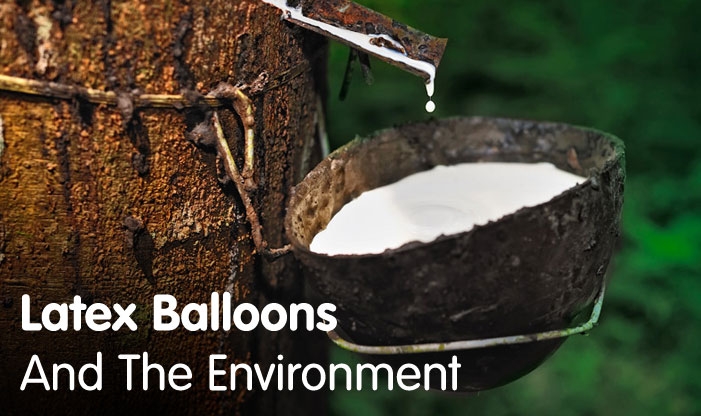The Environment
Latex balloons are an environmentally friendly product.
What are balloons made of?
Balloons are made of natural rubber latex (NRL) which is a natural product coming from rubber trees that are grown in certain areas of the tropics. These are not trees that are cut down to produce the NRL. The NRL is obtained by tapping from mature trees and is a sustainable crop providing employment for many agricultural workers in some of the poorest areas of the world.
As a consequence of NRL cultivation and the consumption of latex products, the planting and maintenance of rubber tree plantations helps towards the prevention of tropical rainforest deforestation. This contributes significantly to the removal of greenhouse gases from the atmosphere, produced by industrialised nations and a major source of global warming.
Are balloons biodegradable?
A latex balloon is completely biodegradable. Oxidation is the first step in the breakdown of a latex balloon and begins within approximately one hour of inflation. Oxidation is visible in some types of balloons as a cloudy appearance. This is most evident when the balloon is exposed to direct sunlight, heat or normal outdoor conditions.
Latex balloons can be composted and will biodegrade at about the same rate as oak leaves. Research has been carried out with a variety of balloons under various conditions to accurately gauge the time needed for the latex to degrade. Results from this study indicate that the decomposition time for balloons is about 6 months.
What is the impact on the environment of releasing balloons?
NABAS, the UK's Balloon Trade Association, is very aware of its responsibilities to the environment and has issued a Code of Conduct for balloon releases.
On release a balloon will float up to a height of approximately 5 miles and then it becomes brittle and shatters, the small pieces being distributed over a wide area. Only natural latex rubber balloons and biodegradable components must be used in balloon releases. Balloons must be hand tied; plastic valves should not be used and any attached labels must be paper, preferably recycled.
Source: NABAS The Balloon Association and The European Balloon Council
Health & Safety
Latex Allergies
Natural rubber latex (NRL) is a milky fluid obtained from the Hevea brasiliensis tree, which is widely grown in South East Asia, and other countries. NRL is an integral part of thousands of everyday consumer and healthcare items.
As with many other natural products, natural rubber latex contains proteins to which some individuals may develop an allergy. NRL is a widely-used and cost-effective material, which for the majority of the population is not a clinical risk.
Who is most at risk?
- Healthcare workers
- Individuals undergoing multiple surgical procedures
- Individuals with atopic allergic disease (a tendency to react to specific allergens, as in hay fever, some skin irritations, and asthma)
- Individuals with a history of certain food allergies, such as banana, avocado, kiwi and chestnut
- Individuals exposed to NRL on a regular basis
Products containing Natural Rubber Latex
Erasers, Rubber bands, Balloons, Condoms, Contraceptive cap, Baby teats, Hot water bottles, Stress balls, Sports equipment, Swimming caps and goggles, Washing-up gloves, Carpets, Adhesives, Tyres Underwear elastic, Shoe soles, Calculator/Remote Control buttons.
What is the cause of Natural Rubber Latex Allergy?
The proteins naturally present in NRL cause the allergies either through direct contact with the skin or by inhalation of powder. For example, NRL allergens attach to cornstarch used in powdered gloves making the NRL proteins airborne when these gloves are used, enabling the allergens to be inhaled.
Source: Health & Safety Executive Guidelines 2008 (see www.hse.gov.uk/latex)
So how does this relate to balloons?
Sensitised persons may experience an allergic reaction due to direct contact with balloons. Some people may experience an irritant reaction when using products made from natural rubber latex, which is known as irritant contact dermatitis. This is not, however, a true allergy.
Cornstarch powder is not used as a de-tack powder in the manufacture of toy balloons. Toy balloons are lightly coated with inorganic filler such as calcium carbonate, diatomaceous earth and clays.
Inorganic minerals do not bind latex proteins and therefore cannot cause protein allergens to become airborne to induce an allergic response from being indirectly exposed to balloons in public places.
Source: TARRC Rubber Consultants Report 2005








